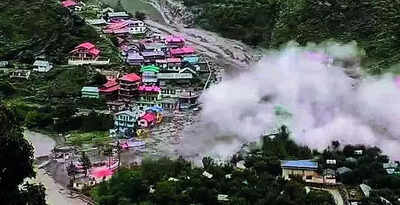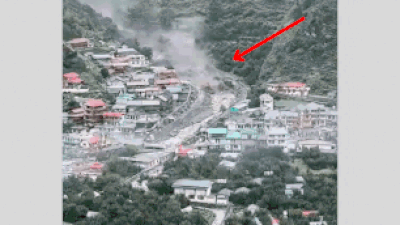DEHRADUN: A glacier collapse or glacial lake breach upstream, rather than the initially suspected cloudburst, likely triggered the flash flood that ravaged Dharali village in Uttarkashi district on Tuesday, experts studying meteorological and satellite data told TOI. As rescue and relief operations continued, scientists began investigating evidence suggesting that a significant avalanche, glacier collapse or lake burst upstream may have unleashed the destructive torrent.IMD recorded minimal rainfall around the time of the disaster, raising questions about the cloudburst theory. Harsil had only 6.5mm rain on Tuesday, and cumulative rainfall over 24 hours was just 9mm in Harsil and 11mm in Bhatwari – figures significantly below levels typically associated with cloudburst-induced flooding.Rohit Thapliyal, senior scientist at IMD’s regional meteorological centre, said, “Only very light to light rain was observed in the affected area over 24 hours. The highest rainfall recorded anywhere in Uttarkashi was merely 27mm at the district headquarters.” Another senior scientist added, “This volume is insufficient to trigger floods of such severity, suggesting a powerful event such as a glacier burst or a GLOF.”Satellite images independently accessed by TOI confirmed the presence of significant glaciers and at least two glacial lakes situated directly above the affected site. “There is a glacier right above Kheer Gad stream; a sudden release of water, either from glacial lake outburst or glacier burst, could lead to a high-energy flash flood, similar to the Raini disaster in Chamoli in Feb 2021,” said the scientist. The Raini incident involved a rock-ice avalanche that triggered floods devastating the Rishiganga hydel project and severely damaging the Tapovan-Vishnugad power plant, resulting in more than 200 deaths.According to Wadia Institute of Himalayan Geology, Uttarakhand has 1,266 glacial lakes ranging from small bodies to large reservoirs, several of which pose significant downstream threats. National Disaster Management Authority identified 13 glacial lakes as high-risk, classifying five as extremely dangerous.Senior geologist and former exec director of Uttarakhand Disaster Management Authority Piyoosh Rautela said, “Such disasters occur when water accumulates at higher elevations and discharges suddenly… Heavy rainfall alone can’t cause such a disaster.”






